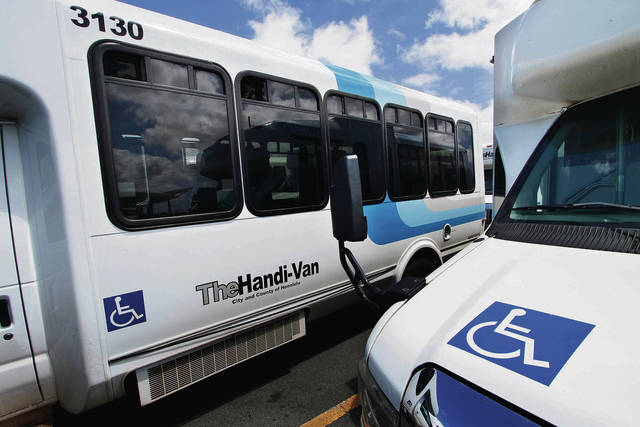For years, city transit officials have struggled to meet Oahu’s demand for Handi-Van service — a demand they say is the highest in the nation per capita. Now, without a fare increase, the service will be stretched “to the point of failure,” those officials are telling City Council members.
While some of the Handi-
Van’s staunchest advocates agree a fare hike is necessary, they caution the move could hurt some of the island’s most vulnerable residents.
“We simply don’t have the vehicles. We don’t have the drivers to serve the extra anticipated demand in the future,” Wes Frysztacki, the city’s Department of Transportation Services director, said Thursday while briefing the Council’s Transportation Committee on a new study. It explores how to keep Handi-Van service sustainable.
Even as the department works on a long-term solution, in the short term “we cannot expand capacity fast enough to keep up with demand,” Frysztacki said. “Service quality will be compromised.”
Handi-Van riders have long complained they wait way too long on the reservation phone line and then for their vans to show up. A city audit Opens in a new tab released last year supported their accounts, finding that on-time rides dropped about 5 percentage points Opens in a new tab between 2013 and 2015 and that riders faced a “significant” number of excessively long trips.
Handi-Van’s fleet of 180 vehicles handles about 3,500 daily rides. The fleet will need even more vans, but the paratransit service’s Middle Street maintenance facility has almost reached capacity, officials say.
The new study Opens in a new tab, done by city consultants Innovative Paradigms and Nelson Nygaard, found that if the service were to improve its on-time performance but not increase its fares, Handi-
Van would see the annual demand for rides increase by nearly 800,000 between fiscal years 2016 and 2022.
Meanwhile, Handi-Van’s $2 fare hasn’t been increased since 2001, officials say.
The study recommends increasing the fare by 50 cents until it reaches $4 as a way to slow growth in demand. The average cost for a trip in a Handi-Van, excluding the taxicabs that often carry such fares, was more than $45 last year, Frysztacki said.
“Yes, it definitely needs a fare increase — no question about it,” Handi-Van user Sam Curtis told the Council members Thursday. Passengers who could take TheBus instead should not take up Handi-Van rides, he added.
Barbra Armentrout, a Handi-Van user who frequently attends public meetings and is a member of the new rate commission, said there should be a fare increase but not as high as $4. That price would confine many current riders living on fixed incomes and below the poverty line to their homes, she said.
Councilman Ikaika Anderson said he has “heartburn” about increasing fares if it doesn’t mean better service.
The department says it’s trying to help more social-
service agencies organize their own transportation services to ease demand on Handi-Van. So far, only larger, national agencies such as Goodwill have been able to do that in Honolulu, Frysztacki said. It’s further encouraging riders to use TheBus where they can, he added.
Transit officials plan to have a “rigorous” discussion on the matter with the city’s new fare commission, Frysztacki said. The City Council would have to approve any increases, he added.

